The Road of the Greek Gods
In this Peloponnese shaped like the fingers of a hand, Athens unveils its Akropolis.
The upper town, with its ancient ruins, crystallizes the entire history of Greece.
Designed by Pericles as monumental, the Propylaea provided access to the Acropolis.
The Parthenon, dating from 438 BC, was dedicated to Athena, goddess of War and Wisdom.
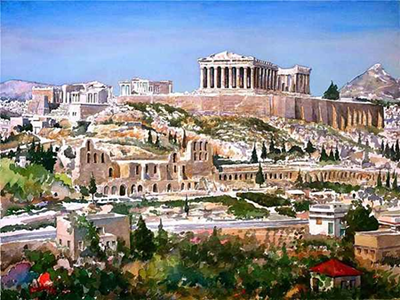
Watercolor of the Parthenon by Pantelis Zografos
The Ionic order temple of the Erechtheion consisted of several sanctuaries,
Dedicated to Zeus, Poseidon, and Athena, with the eternal sacred tree of the ancient olive tree.
The portico of the Caryatids, composed of six statues of young girls, draped in peplos,
Supports the platform used by officials during the Panathenaic ceremonies.
On the southern slope, in the Theater of Dionysus,
the great Dionysia festivals took place every year in honor of the God of Wine.
The stands could seat 17,000 spectators, in 78 rows.
The dignitaries, in the marble proedria with backs, sat on 67 divine seats.
The Agora, where the city's social life took place, had its own thoroughfare.
From the Altar of the Twelve Gods to the Church of the Holy Apostles, where processions passed,
The Bouleterium, or Council Chamber, ensured Justice and Democracy.
Facing the Agora, the Theseion was dedicated to Hephaestus, God of Metallurgy.
In front of the Hellenic Parliament, the "Evzones" perform a surprising ballet for the changing of the guard.
The soldiers of the guard, bayonets fixed, wear the "foustanella" with its 400 pleats,
The "fario," a felt cap, the "boudouri," socks with attached garters,
And the "tsarouchia," studded clogs with tassels clacking on the polished marble.
Across the majestic plain of Thessaly, en route to the astonishing Meteora,
Facing the mythical Mount Olympus where the ancient gods rest, under the protection of Zeus,
Towards Kalambaka, 300 meters high, on rocky peaks of graying sandstone,
Orthodox monks have built monasteries beyond the reach of the evil Turks.
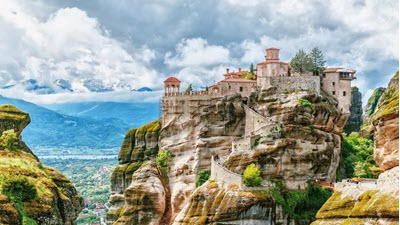
Since 1380, Grand Meteora has "hovered between heaven and earth" on the largest, lofty rock.
Perched on another peak, Roussanou is inhabited by nuns.
On the ruins of St. Barbara's Church, the Byzantine-style Catholicon was built.
The 60 rocky peaks contain 24 monasteries, of which only 6 remain in operation.
On the slope of Mount Parnassus, the imposing sanctuary of Delphi,
Built in honor of the god Apollo, as early as 800 BC, enjoyed its heyday.
The city of the "demiurges" elected 9 "prytans," one of whom was the notorious "archon."
The Pythia collected the "pelanos," a tax for consulting Apollo's oracle.

Stop in Corinth to admire Nero's project in the Peloponnese.
He wanted to connect the Saronic Gulf in the Aegean Sea to the Gulf of Corinth in the Ionian Sea.
The Corinth Canal was not dug until 1881 by a French company.
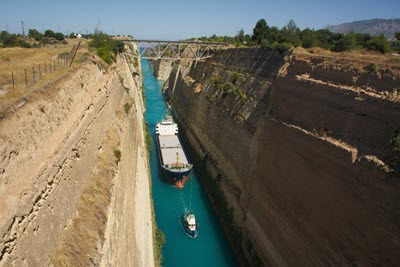
On the Acropolis of Mycenae, the citadel of the Atrides was built by warrior aristocrats.
Surrounded by Cyclopean walls, the Lion Gate forms the entrance to this place.
It was here that Agamemnon, the "cruel lion," decided on the expedition against Troy.
At a depth of 18 meters, one can access the underground cistern carved into the rock.
Stop at Lygourio to discover the 4th century BC Theater of Epidaurus.
14,000 people could attend popular performances on 55 rows of stands.
In the middle of Nafplio's harbor, protecting the city from pirates, stands the fortified islet of Bourtzi.
On the rocky peak, the Venetians erected the Palamidi Fortress in 1711.
From Mykonos to Santorini
On Mykonos, lapped by the waves, the white and blue cubic villas of the windswept seafront,
Line the tangle of labyrinthine alleys, protecting them from the fierce winds.
The mills of this St. Tropez on the Aegean Sea were used by families to grind wheat.
At the old port, the medieval church with five chapels, Panagia Paraportiani, served as a lighthouse.
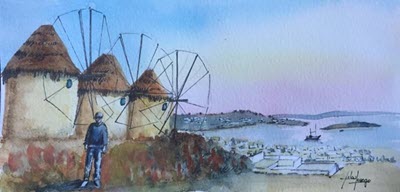
The Windmills of Mykonos by Lilou Losego
On Patmos, the Jerusalem of the Aegean Sea, the Orthodox Monastery of St. John the Theologian,
Founded in 1088 on the hill where the Temple of Artemis once stood, dominates the Dodecanese island.
Between the Chora and Skala, the Cave of the Apocalypse is of course a must-see.
The Apostle John, Christ's favorite student, is said to have written his Revelations there about the terrifying end of humanity.
The capital of the Dodecanese, Rhodes, was founded by the Dorians around 408 BC.
It is to Helios, the Hellenic sun god, that we owe the opening of the ancient port.
In this medieval city with its 4 km of ramparts, Fort St. Nicholas protects the port of Mandraki.
Its 30 m high colossus was the sixth of the Seven Wonders of the World, now lost.
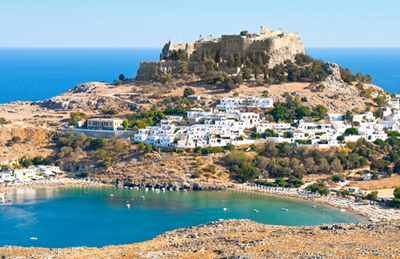
With its dazzling white houses and its Crusader castle perched on its acropolis,
Lindos, perched above the sea, displays its lace creations, including Alexander the Great,
wore a garment made by the seamstresses during his visit around 335 BC.
Along the path leading to the acropolis, lies the famous Hellenistic engraved stone.
This votive exedra from Lindos depicts the stern of a "trireme," an Ionian warship.
The work of Pythokrites, the author of the Winged Victory of Samothrace, is exhibited at the Louvre Museum in Paris.
The 8th century BC Temple of Athena was fortified in the 13th century by the Knights of St. John.
The imposing 16th century Ampouaz Gate opens onto the "Bourg" where Jews, Greeks, and Ottomans resided.
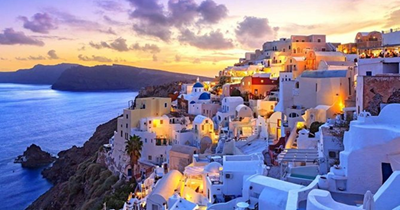
At the heart of an impressive caldera, Santorini, the most volcanic of the Cyclades, lies
It can be visited either by donkey or by coach along the winding road leading to Fira
In the north of the island, Oia boasts its famous "skafta" cave houses
Its winding marble-paved streets lead to blue-domed churches that blend into the azure sky.
Guy PUJOL says l’ARIÉ….JOIE
